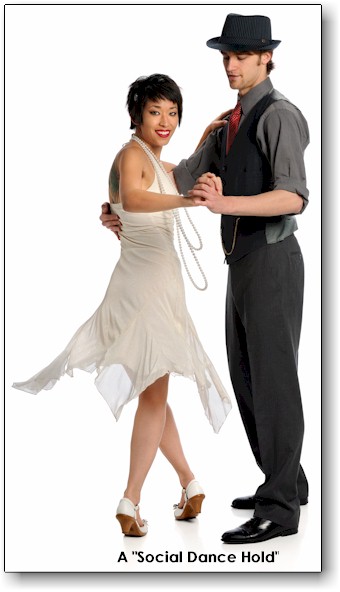
| Home Page | Our Current Schedule | What is social Dancing | Social Dance Etiquette |
Social Dance Etiquette
"Social Dancing" is partner dancing, intended for participation, rather than competition or exhibition. The objective of Partner Dancing is to form and strengthen interpersonal relationships and social connections using fun partnered movements to music. As a social function, dancing requires social grace as well as physical grace. Social grace, dance etiquette and common courtesy are more important than a social dancer’s talent and physical technique. Considerate, thoughtful dance partners have the most dance opportunities and the most fun, regardless of their technical competence.
To this end, the following guidelines for Dance Etiquette are provided.
MAY I HAVE THIS DANCE?
At a social dance, you may ask anyone to dance, and women may ask men to dance. When you ask someone to dance, make eye contact and ask clearly, “May I have this _____ with you?” saying the type of dance (Waltz, Cha Cha, etc.). If your partner says yes, smile, offer your hand, and escort him or her onto the dance floor and into dance position.
YES, THANK YOU
When someone asks you to dance, your response may be, “Yes, thank you.” At a social dance, it is customary to say “yes” when someone asks you to dance. In vibrant dance communities, social dancers are supportive and kind to each other at all skill levels.
SAYING NO
First of all, NO MEANS NO. At a social dance, anyone may ask anyone to dance. On the other side of this coin, it is OK for anyone to say no, and you do not have to explain or justify your no. It is not appropriate to say no simply because the person does not dance at your level, dancers do not improve without practice and experience with better dancers. It is appropriate to say no if a person is; repeatedly asking you to dance, drunk, or is physically or verbally inconsiderate, rude, inappropriate, abusive, aggressive or threatening. If someone will not accept no for an answer, or is behaving inappropriately, please tell an event host (they are wearing name badges).
SAYING NO WITH SOCIAL GRACE
Saying NO should not be awkward, here are some suggestions. If you say NO, but would like the person to ask again, include a "please ask again".
- No, thank you.
- No, thank you, I only dance with my spouse, partner, friend, etc.
- No, thank you, we've danced a lot and I'd like to dance with some other people.
- No, thank you, I'm saving this dance for someone / I've promised this dance to someone.
- No, thank you, I'm not comfortable dancing this _____ (song, Waltz, etc.), please ask me for a _____ (Cha Cha, Salsa, etc. )
- No, thank you, but please ask me again.
|
HOW CLOSE IS TOO CLOSE? (THE SOCIAL DANCE HOLD) There is nothing more uncomfortable for a dancer than being pressed up against someone they’d rather not be pressed up against. The "Social Dance Hold", with space between the partner's bodies, is common courtesy at social dances. Your partner has the right to determine appropriate closeness, regardless of what you believe is the “correct” way. DANCING THE DANCE Again, dancing is about making a connection with your dance partner. Making a connection means dancing WITH your partner, not out-dancing them, and not leaving them feeling bad about their technical competence. Be aware of your partner, smile, make eye contact, (don’t stare). The popular dancers do not necessarily have high technical competence, but they are always considerate, gracious and appreciative. At the end of the dance, ALWAYS say THANK YOU to your dance partner and walk off the floor together. CIRCULATING At a social dance, it is appropriate to dance with a variety of people. It is an opportunity to meet and form social connections with new people. CLEANLINESS IS HEAVEN AT A DANCE Social dancing is a quasi-intimate activity requiring physical closeness. Good hygiene shows respect and consideration for other dancers. Bathe, brush your teeth, use deodorant, breath mints, and wear clean clothes that will not be too hot. Dancing is a work out! If you perspire heavily while dancing, bring a towel and/or fresh shirt to change into. If wearing perfume or cologne, use a light touch, some people are sensitive to fragrances. YOUR PARTNER’S TECHNIQUE Assume your partner is dancing the best they can. If your partner is dancing off time, assume they are not doing it intentionally. Unless they ask for your help, don't volunteer to critique their dancing. If your partner is physically hurting you, it is probably inadvertent. Stop dancing and say “I’m sorry, but you’re _____ (holding my hand to tightly, etc.). Could we try again?” If your partner responds inconsiderately, or seems unwilling to modify their behavior; say, “thank you, but I’d like to stop now” and walk off the dance floor. |
 |
THIS IS OVER MY HEAD!
If you really can’t get the step, tell your partner that you’re having trouble and need to step off the dance floor.
FLOOR CRAFT
Everyone must be considerate and aware of their surroundings in order for a social dance to be safe and fun. Watch where your going to avoid running into other dancers. Do not swing your arms on, or race across a crowed dance floor, be considerate of fellow dancers.
At times, collisions will occur. Everyone involved should stop and apologize, regardless of whose “fault” it was. If someone has been hurt, make sure they are okay before you resume dancing. If necessary, escort them off the floor to a chair and see if they need ice, a drink of water or medical attention. If someone cannot get up on their own, do not move them, call 911.
NOT ON THE DANCE FLOOR
The dance floor is for dancing. Do not take food or drink onto the dance floor, cut across it or stand on it for conversations.
THE PURPOSE OF DANCING
The purpose of social dancing is to connect and interact with other human beings in a fun and healthy way. A “good dancer” is not the best looking dancer on the floor. A “good dancer” is someone who connects and interacts with their dance partner in a way that is considerate, supportive and enjoyable for both. Partner dancing is not a performance, and it is not about winning or losing. It is an activity which is, above all else, about having fun interacting with another person through partnered movements to music.
IF YOU HAVE A PROBLEM
If you have a problem, please tell an event host. Event hosts are wearing name badges, and you will see some of them on stage or making announcements. We want our dances to be fun and enjoyable for everyone, don't let someone spoil you fun. Dance Plattsburgh attendees agree to behave respectfully and in accordance with this "Social Dance Etiquette".
IN CONCLUSION
Learning to dance competently is important and does take time. However, the "popular" dancers are typically those with good etiquette, and not necessarily the best dance skills. While dancing can be difficult for some to learn, and does take time to develop competence; common sense, common courtesy and respect for others are the common characteristics of "popular" dancers.
See you on the dance floor!
 |
Dance Plattsburgh is USA Dance Inc., Dance Plattsburgh NY Chapter #3068.
We are a 501(c)(3) not-for-profit organization providing dance education
and opportunities in local communities by organizing affordable
social dances, dance lessons and workshops. |
Please thank our sponsors who help make our events possible:

